|
@Who could predict todayfs remarkable global popularity of Sushi until a decade ago? Sushi is now considered an exclusive representative of Japanese cuisine. The Japanese people love sushi, however, they do not live only on sushi. Sushi is just a part of Japanese cuisine. It is a special food to the Japanese, too. I was so amazed when I found a small sushi stand even in a desert area of scorching heat in Israel/Palestine when I had a wonderful chance to visit there in 2005.
@Sushi outside Japan has been varied and flourishing in forms and ingredients according to their limited availability, which makes the sushi sometimes look far from the traditional one made and eaten within its original country.
Definition of Sushi
@The definition of sushi today in the mind of most of the Japanese and all the people in the world who know sushi is the combination of vinegared rice and slices of other ingredients such as raw fish, cooked fish and vegetables. There is now a sushi with even raw beef. In fact, all the ingredients are not necessarily used as toppings, however. Some are chopped and mixed with the sushi rice, and there are many variations. Because the sushi of rice balls with different toppings have become so popular overseas as well as in Japan in recent years, many people might think that only this is the sushi.
Origin of Sushi
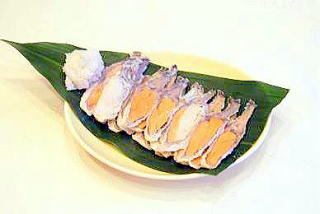 Sushi debuted more than a thousand and 7 hundred years ago in an entirely different form. Sushi debuted more than a thousand and 7 hundred years ago in an entirely different form.
It is reported by some anthropologists that the earliest sushi was found in southern Asian countries such as Burma (Myanmar), Laos, and Thailand. It was brought to southern China first and then to Japan in the 3rd century with the diffusion of the new agricultural technology of growing rice in the rice paddy and the art of rice cooking.
In these days, cooked rice and a kind of raw fresh water fish were packed in a barrel or a jar with lots of salt as a way of preserving fish by fermentation. The preserved fish with rice and salt tastes slightly sour but delicious, an excellent result from the fermentation process.
@ Incidentally, the sushi closest to the original form is still available
in some parts of Japan. A good example is the one in Shiga prefecture.
The people there make what they call "funa-zushi" (carp sushi)
with the carp they fish in Lake Biwa, the largest lake in Japan, in the
coldest time of the year and pack them in barrels with cooked rice and
salt for fermentation. It is now a delicacy. It smells like Limburger cheese,
but full of flavor and so delicious!
@ I had an experience of watching how the sushi be prepared by a fisherman in my middle teens. My grandmother who used to live in a town close to Lake Biwa invited a well-trained fisherman from the lakeside to come to her house and had him make it. The season was the spring, egg-laying time of the fish. All the fishes (a kind of carp) the fisherman brought were packed with beautiful orange color roe in them.
@ The old fisherman scaled and gut the fishes carefully and skillfully
so as not to damage the roe. He packed a huge barrel tightly with the cleaned
fishes and strong salt. After packing, he sealed the barrel and put a heavy
weight of stone and filled the barrel with fresh and clean cold water from
the well of my grandmotherfs house. It was kept for months but the water
had to be changed every morning while the water of the well was still very
cold.
@ The fisherman came back again in the summer to check if the fish in the
barrel were all right and well fermented. Then the fishes were taken out
to be washed in cold water in order to be desalted and wiped dry. The barrel
was cleaned. The fisherman filled the barrel again with the desalted fishes,
freshly boiled rice, and salt. It was covered and sealed tightly again.
The fresh cold water was poured into the barrel. It was preserved for half
a year or so, changing the water daily for perfect fermentation.
@ The fermented fish obtained this way is thinly sliced to serve as an appetizer. The rice is mostly liquidized, however some people love it as well. It is delicacy although it smells even stronger than the fish itself.
@ In a small village called Makino by Lake Biwa, there is a restaurant
named Korian, where they serve full course dinner wit this particular sushi.
The name Korian was named after the nickname of the world famous Japanese
novelist, Endo Shusaku, because he would love this restaurant so much.
Endo called himself Korian for his non-serious, casual writings. The name
of the restaurant and Endofs nickname sounds exactly the same, but is written
in three different Chinese characters, respectively, and means totally
different. For Korian restaurant, the character ko means elakef, ri means
eraccoon dogf, which are believed to cheat and trick although an is the
same ecottage.f
@You could visit the restaurantfs web site at http://www.korian.net/ although it is all in Japanese unfortunately.
Transition of Sushi
@The sushi of this kind was eaten for fairly long time until Edo period in 17th century. In Edo period, peoplefs life became busy due to the development and progress of industrial technology. They did not have the patience to wait for this long process of making sushi. On the other hand, vinegar had been already used in daily cooking. They started to use the vinegared rice and lightly marinated fish slices instead. This is the beginning of today's sushi.
@
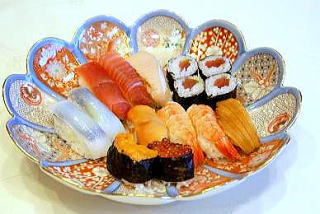 Today, because of the increasing number of sushi bars, many people may
think that sushi means only the Tokyo style sushi (Edo-mae-zushi), which
is the small ball of vinegared rice topped with a slice of, largely, raw
fish. Today, because of the increasing number of sushi bars, many people may
think that sushi means only the Tokyo style sushi (Edo-mae-zushi), which
is the small ball of vinegared rice topped with a slice of, largely, raw
fish.
@Edo-mae-zushi used to be made with the fish and shellfish only from the Tokyo Bay and its surrounding sea. When the cooling or refrigerating system was unavailable, they often cook the fish and shellfish and tried to keep them longer by marinating in soy sauce. In fact this kind of method of making sushi seemed reasonable for the short tempered Edo people then.
@ When a Japanese hear the word, sushi, however, he/she may think of something different depending on where he/she is from. In Osaka, for example, they still have what they call "Osaka-zushi", Osaka-style sushi, cooked rice packed in a square mold topped with various cooked ingredients, and pressed.
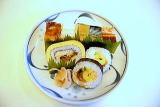  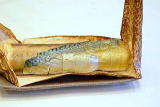 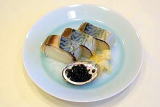
@In fact, there is a great variety of sushi in Japan. In different regions of Japan, they make their original sushi, using their own regional fish and vegetables. However, they are all combinations of vinegared rice and a great variety of ingredients.
Sushi And Life Of The Japanese
@ Sushi has often been made to celebrate seasonal events in Japan. In each
village and town in Japan, they celebrate some sort of festivals in all
seasons. They make their own traditional sushi. Sushi is also made for
the lunch to take out such as sport events at childrenfs school, Sakura
observation festival and so forth.
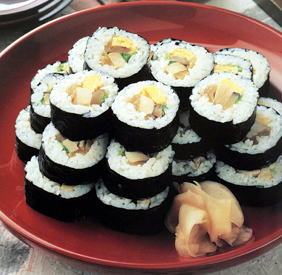 |
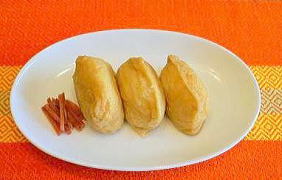 |
@The sushi for these occasions is often what can be eaten with fingers such as Sushi in Fried Tofu Pouches or Thick sushi Rolls filled with cooked vegetarianfs food.
Some people make the sushi of their choice to celebrate the family events such as their birthday, graduation, entering new school, getting new job, memorial day, and so on.
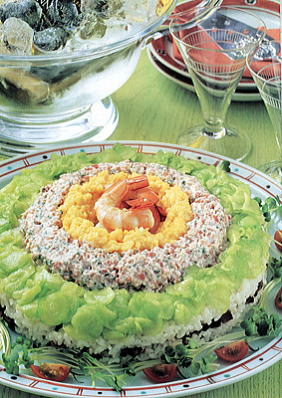 @ Tokyo style sushi is expensive fast food and is seldom made at home,
since it is not only expensive but it requires trained techniques to make.
All different kinds of homemade sushi is handed down from generation to
generation. It has been the intangible family treasure. You could create
your own home made sushi just by mastering the technique of making sushi
rice. I am introducing you a sample of sushi that anyone can make easily
without special technique. Please click the Recipe page of this web site. @ Tokyo style sushi is expensive fast food and is seldom made at home,
since it is not only expensive but it requires trained techniques to make.
All different kinds of homemade sushi is handed down from generation to
generation. It has been the intangible family treasure. You could create
your own home made sushi just by mastering the technique of making sushi
rice. I am introducing you a sample of sushi that anyone can make easily
without special technique. Please click the Recipe page of this web site.
@
Keiko Hayashi
|
 Sushi debuted more than a thousand and 7 hundred years ago in an entirely different form.
Sushi debuted more than a thousand and 7 hundred years ago in an entirely different form.  Today, because of the increasing number of sushi bars, many people may
think that sushi means only the Tokyo style sushi (Edo-mae-zushi), which
is the small ball of vinegared rice topped with a slice of, largely, raw
fish.
Today, because of the increasing number of sushi bars, many people may
think that sushi means only the Tokyo style sushi (Edo-mae-zushi), which
is the small ball of vinegared rice topped with a slice of, largely, raw
fish.





 @ Tokyo style sushi is expensive fast food and is seldom made at home,
since it is not only expensive but it requires trained techniques to make.
All different kinds of homemade sushi is handed down from generation to
generation. It has been the intangible family treasure. You could create
your own home made sushi just by mastering the technique of making sushi
rice. I am introducing you a sample of sushi that anyone can make easily
without special technique. Please click the Recipe page of this web site.
@ Tokyo style sushi is expensive fast food and is seldom made at home,
since it is not only expensive but it requires trained techniques to make.
All different kinds of homemade sushi is handed down from generation to
generation. It has been the intangible family treasure. You could create
your own home made sushi just by mastering the technique of making sushi
rice. I am introducing you a sample of sushi that anyone can make easily
without special technique. Please click the Recipe page of this web site.